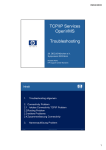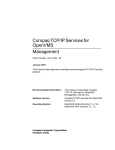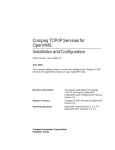Download TCP/IP Services for OpenVMS Troubleshooting
Transcript
TCP/IP Services for OpenVMS Troubleshooting DECUS München e.V. 25. Symposium 2002 Bonn Norbert Wörle COMPAQ Customer Support Center Wo fange ich an zu suchen? ? 1 Inhalt 1. 1.1 1.2 1.3 1.4 1.5 1.6 1.7 Wo fange ich an zu suchen Troubleshooting Connectivity: Ping Troubleshooting Connectivity: Interface Troubleshooting Connectivity: Routing Troubleshooting Connectivity: Traceroute Troubleshooting Connectivity: Zusammenfassung Ping Troubleshooting Connectivity: Namensauflösung Troubleshooting Connectivity: Zusammenfassung Inhalt (cont) 2. Troubleshooting Applikationen • 2.1 Troubleshooting Services allgemein 3. Troubleshooting Connectivity: Tcptrace 4. Anhang • 4.1 Troubleshooting Applikationen - Remote Computing Utilities • 4.2 Troubleshooting Applikationen - File Transfer Utilities • 4.3 Troubleshooting Applikationen - Resource Sharing • 4.4 Troubleshooting Applikationen - Eletronic Mail • 4.5 Troubleshooting Applikationen - Network Services 2 1. Wo fange ich an zu suchen? Funktionieren nur einzelne Applikationen nicht ? • Troubleshooting Applikationen _______________________ Application Layer Transport Layer Internet Layer Sind gesamte Knoten oder Netzwerke nicht erreichbar ? • Troubleshooting Connectivity Network Access Layer 1.1 Troubleshooting Connectivity: PING Start Ist TCP/IP korrekt gestartet? Tcpip> ping 127.0.0.1 Tcpip> ping <eigene IP Adresse> Tcpip> show interface Ist der remote Host erreichbar? Tcpip> ping <remote-ipaddress> Netzwerk Interface, Routing, ARP Cache prüfen 3 Troubleshooting Connectivity - PING (cont) PING - ICMP Echo Request/Echo Reply Pakete TCPIP> ping/number=3 16.204.233.45 PING 16.204.233.45 (16.204.233.45): 56 data bytes 64 bytes from 16.204.233.45: icmp_seq=0 ttl=255 time=2 ms 64 bytes from 16.204.233.45: icmp_seq=1 ttl=255 time=1 ms 64 bytes from 16.204.233.45: icmp_seq=2 ttl=255 time=1 ms ----16.204.233.45 PING Statistics---3 packets transmitted, 3 packets received, 0% packet loss round-trip (ms) min/avg/max = 1/1/2 ms TCPIP> ping [ /number=3 ] 10.11.12.13 PING 10.11.12.13 (10.11.12.13): 56 data bytes ----10.11.12.13 PING Statistics---3 packets transmitted, 0 packets received, 100% packet loss %SYSTEM-F-TIMEOUT, device timeout 1.2 Troubleshooting Connectivity: Interface PING <IP Adresse> funktioniert nicht – Ist lokales TCP/IP gestartet ? » TCPIP> show interface ($ifconfig -a) – Sind IP Adresse, Netzwerkmaske, Broadcastmaske okay » TCPIP> show interface/full – Gibt es Hardwareprobleme » Send / Receive counters anschauen Interface: WE0 IP_Addr: 16.204.233.30 NETWRK: 255.255.255.0 BRDCST: 16.204.233.255 ..... Ethernet_Addr: AA-00-04-00-6C-C6 MTU: 1500 Flags: NONE RECEIVE SEND Packets 5314628 435682 Errors 0 0 Collisions 0 0 4 Troubleshooting Connectivity - Interface (cont) Werden Pakete gesendet / empfangen, zählen Fehler hoch ? • NETSTAT $ netstat -i $ netstat -s $ netstat -ia $ netstat -an $ netstat -m interface Statistik (TCPIP> show interf/full) protocol Statistik (TCPIP> show protocol) zeigt alias und multicast Adressen per-connection Status (TCPIP> show device) memory buffer output (TCPIP> show comm/mem) Kontrolle ob checksums, excessive retransmissions, drops, out of order packets, lost carrier errors, etc. auftauchen. Doppelt vergebene IP Adresse? • TCPIP> show arp ( $arp -a ) 16.204.233.72 aa-00-04-00-aa-c6 1.3 Troubleshooting Connectivity: Routing kein Routing Eintrag error „ no route to host „ (TCPIP 5.x) error “remote node is not currently reachable” (UCX 4.x) Routingtabelle : $tcpip> show route oder netstat -rn Type AH AN AH AN AN AH Destination Gateway 127.0.0.1 127.0.0.1 Loopback Adresse 16.204.233.0/24 16.204.233.30 Route ins eigene Netz 16.204.233.30 16.204.233.30 Route zur eigenen IP-Adr. 0.0.0.0 16.204.233.222 Default Gateway 10.0.0.0/8 16.204.233.20 Gateway nach 10... 20.1.1.30 16.204.233.40 Gateway zu host Ist das entsprechende Gateway erreichbar? » Tcpip> ping <gateway> 5 Troubleshooting Connectivity: Routing (cont) Wie kommen Einträge in Routing Table ->Routing Setup? • Dynamisches oder statisches Routing? • Tcpip> show config start routing -->error --> nur statisches Routing Statisches Routing (manuelles Eintragen der Routes) – TCPIP> show route/perm – TCPIP> set noroute .... [/perm] Dynamisches Routing (RIP) (Routes werden „gelernt“) – TCPIP> show route/perm – TCPIP> start routing/log – $ reply/enable » Anzeigen der empfangenen RIP Routing Pakete ICMP Redirects : netstat -rn -> Flag : M oder D 1.4 Troubleshooting Connectivity - TRACEROUTE Tool zum Überprüfen des Routing Pfades • benutzt IP TTL Feld $ traceroute 16.1.0.2 traceroute to gatekeeper.pa.dec.com (16.1.0.2), 30 hops max, 1 zk1rt4.zko.dec.com (16.33.16.104) 5 ms 4 ms 5 ms 2 lkd2-zko-pp.bb.dec.com (16.55.160.1) 18 ms 43 ms 20 ms 3 bblkd1.bb.dec.com (16.54.16.1) 25 ms 21 ms 34 ms 4 mkd1-lkd1-pp.bb.dec.com (16.55.16.2) 40 ms 48 ms 29 ms 5 wrl-mkd1-pp.bb.dec.com (16.55.117.2) 1203 ms 1191 ms 1238 6 easy-pa-gw2.pa.dec.com (16.1.224.101) 1233 ms 1304 ms 1273 7 *** 8 *** CTRL-C 6 1.5 Zusammenfassung Ping $TCPIP> ping/number=3 11.11.11.11 ($ping -c 3 11.11.11.11) „device timeout“ – Kabel nicht connected : » TCPIP> show interface <interface> /full » Send counter errors zählen hoch – Remote Host antwortet nicht » TCPIP> show interface <interface> /full » nur Send counters zählen hoch (nicht errors) » falscher Route Eintrag „no route to host“ --> kein Route Eintrag » TCPIP> show route Troubleshooting Connectivity cont. Start Tcpip> ping <remote-ipaddress> funktioniert !!!!! ( ICMP ) funktioniert Internet Layer OK Network Acc. OK Funktioniert Tcpip> ping <remote-hostname>? Namensauflösung überprüfen, 7 1.6 Troublesh. Connectivity: Namensauflösung Überprüfen lokale Hostdatabase • TCPIP> show host/local <hostname> Überprüfen Bind Namensauflösung : • TCPIP> show host/nolocal <hostname> oder • $ nslookup <hostname> (foreign Kommando definieren!) BIND Client : - TCPIP> show name » » » » Local domain: MUH.COMPAQ.COM State: Started, Enabled Domain: MUH.COMPAQ.COM Servers: 10.10.10.10, 16.16.16.16 - TCPIP> show communication » Local host: mun01 Domain: MUH.COMPAQ.COM Bind Server : Systemmanager das Bindservers Troubleshooting Namensauflösung Mögliche errors : $TCPIP show host/nolocal <hostname> • %TCPIP-W-NORECORD, information not found -RMS-E-RNF, record not found error kommt sofort – Hostname ist bei Bindserver nicht eingetragen – Domain falsch bei TCPIP> show name error kommt mit Zeitdelay (1-2 Minuten) – Bindserver Problem » nicht erreichbar » Bind Prozess Probleme • %TCPIP-E-HOSTERROR, cannot process host request -TCPIP-E-BINDDISABLE, BIND resolver is disabled -TCPIP-E-BINDNOTINIT, BIND resolver not initialized Bind Client ist nicht gestartet 8 1.7 Zusammenfassung Start Tcpip> ping <remote-ipaddress> tcpip> ping <remote-hostname> funktioniert !!!!! Internet Layer OK Network Acc. OK ICMP und Namensauflösung funktionieren (evtl. Test von TCP mit anderer Applikation wie Telnet, FTP etc.) Troubleshooting Applikationen 2. Troubleshooting Applikationen File File Transfer Transfer Electronic Electronic Mail Mail Application Remote Remote Computing Computing Network Network Services Services Transport Resource Resource Sharing Sharing Internet Network Interface Hardware 9 2.1 Troubleshooting Services - allgemein Erste Frage: Funktioniert Client oder Server nicht Client ist der Host, der Verbindung “anfängt” funktioniert mein Client mit anderen Servern ? funktionieren andere Clients mit diesem Server ? Client hat Problem : einige Applikationen mit Logfiles – SMTP – LPD – Telnetsym – NTP einige Applikationen mit Debug / Traceoptionen – Telnet – Bind Troubleshooting Services - allgemein Server hat Problem : • Services sind die Implementierungen der Server Applikationen ---> zuständig für incoming Client Requests • Konfiguration erzeugt für Server Applikationen: VMS Account tcpip$<service> Directory sys$sysdevice:[tcpip$<service>] Startup/Logfiles tcpip$<service>_run.log weitere Logfiles existieren für jeden “incoming” Service (Server Applikation) und teilweise auch für outgoing Client Applikationen Extended Logging durch Definieren bestimmter Logicals 10 Troubleshooting Services “show service /full” Service muß enabled sein TCPIP> show service TCPIP> enable service <service> Überprüfen, ob Server Prozess läuft (TCPIP 5.1) TCPIP> show service <service-name>/full sieht man: • unter welchem Account wird Service eingelogged • auf welches Login-Directory wird Service eingelogged • welche Startup-Kommando Prozedur wird ausgeführt • welches Logfile wird verwendet • Ist das Servicelimit hoch genug? • Security: Dürfen alle Hosts bzw. Netzwerke diesen Service nutzen? Troubleshooting Services “show service /full” TCPIP> show service ftp/full Service: FTP Port: Inactivity: Limit: File: Flags: 21 5 10 State: Enabled Protocol: TCP User_name: TCPIP$FTP Active: 0 Address: 0.0.0.0 Process: TCPIP$FTP Peak: 1 TCPIP$SYSTEM:TCPIP$FTP_RUN.COM None Socket Opts: Rcheck Scheck Receive: 0 Send: 0 Log Opts: Acpt Actv Dactv Conn Error Exit Logi Logo Mdfy Rjct TimO Addr File: SYS$SYSDEVICE:[TCPIP$FTP]TCPIP$FTP_RUN.LOG Security Reject msg: not defined Accept host: 0.0.0.0 Accept netw: 0.0.0.0 11 Troubleshooting Services TCPIP$INET_ACP TCPIP$inet_acp (Auxiliary Server, Inet-Daemon) • dieser Prozess wird beim Starten von TCPIP erzeugt “hört” auf entsprechende Client Requests TCPIP 5.0A : “logged” requesteten Service über dessen Account ein und startet den entsprechenden Service TCPIP 5.1 : Service wird bereits beim TCPIP Start gestartet BootP Server TCP/IP UDP/IP Auxiliary Server SMTP Receiver FTP Server LPR Receiver Troubleshooting Services - allgemein Event Logging ($reply/enable) • Beim Starten jedes Services werden entsprechende Events vom Auxiliary Server (TCPIP$inet_acp) erzeugt • Frage : – kommt request von Remote-Host an ? » TCPTRACE » Events – mit welchem error (event) wird request abgewiesen ? – Evtl. Restart Serverprozess (bei TCPIP 5.1) 12 Troubleshooting Services - allgemein $reply /enable=network %%%%%%%%%%% OPCOM 9-MAR-2000 14:57:38.29 %%%%%%%%%%% Message from user INTERnet on MDSC38 INTERnet ACP Process creation success $ %%%%%%%%%%% OPCOM 9-MAR-2000 14:57:38.30 %%%%%%%%%%% Message from user INTERnet on MDSC38 INTERnet ACP FTP Accept Request from Host: 16.204.43.15 Port: 1419 $ %%%%%%%%%%% OPCOM 9-MAR-2000 14:57:38.67 %%%%%%%%%%% Message from user INTERnet on MDSC38 INTERnet ACP detected TCPIP$FTP exiting before 'accept' $ %%%%%%%%%%% OPCOM 9-MAR-2000 14:57:38.67 %%%%%%%%%%% Message from user INTERnet on MDSC38 INTERnet ACP AUXS error during process exit Status = %CLI-E-NOCMDPROC 3. Troubleshooting Connectivity: TCPTRACE - Tracen nur zu und von eigenem Host - Raw Packet Dump Application Transport Internet TCP UDP IP ICMP Network Access 13 Troubleshooting Connectivity: TCP Segment z.B. 21 = FTP 23 = Telnet Application Well-known TCP Ports TCP Segment Transport TCP Source Port TCP Destin.Sequence Acknowl. Flags Port Number Number Window Checksum Data IP Datagram Internet ..... Fragment TTL Protocol Header Source Destination Offset Checksum IP Address IP Address Data Ethernet Frame Network Access MAC Preamble Dest. Address MAC Source Address Type / Ethernet Data CRC Length Troubleshooting Connectivity: TCP Header Format 0 31 15 16 Source Port # Destination Port # Sequence # meist 20 Bytes Acknowledgement # Data Offset Not used U A P R S F R C S S Y I G K H T N N Checksum Urgent Pointer Options (if any) ------------------ Window Size DATEN Padding -------------------- 14 Troubleshooting Connectivity: TCP Header Format Bedeutung der Flags SYN: Synchronisierung der Sequence Nummern zum Aufbau FIN: RST: ACK: PSH: URG: einer Verbindung Sender beendet Datentransfer, Verbindungsabbau Reset der Verbindung Quittierung der empfangenen Daten Senden von Daten ‚Urgent‘ Daten Troubleshooting Connectivity - TCPTRACE $ TCPTRACE <host> (TCPIPTRACE in UCX 4.2) Optionen : • /buffers = n (Anzahl der zum Zwischenspeichern verwendeten Buffer) • /full (zeigt auch die Paketdaten mit an) • /output=filename (speichert den Output in einem File) • /packets=n (Anzahl der zu tracenden Pakete) • /port=[ local | remote ]=n (filtert die Pakete für einen bestimmte Port) • /protocol=[arp, icmp, ip, tcp, udp] Trace mit CTRL-C beenden 15 TCP Handshake / Open Connection Bsp. FTP Client $ ftp <ftp server> FTP Server Server quittiert SYN (Sequence Nr. + 1 Segment) Source Dest. Seq. Ack. Flags ... 1116 21 15350 0 SYN 86592 Source Dest. Seq. Ack. Flags ... 1116 21 15350 18970 ACK 86593 88001 established Source Dest. Seq. Ack. Flags ... 21 1116 18970 15350 SYN,ACK 88000 86593 Client quittiert SYN vom Server (Sequence Nr. + 1 Segment) TCPTRACE/FU Verbindungsaufbau: SYN TCPIPtrace full display XMT packet 16 at 13-APR-2001 15:35:24.12 (Paket passt nicht zum Bsp!) IP Version = 4, IHL = 5, TOS = 00, Total Length = 48 = ^x0030 IP Identifier = ^x45C7, Flags (0=0,DF=0,MF=0), Fragment Offset = 0 = ^x0000, Calculated Offset = 0 = ^x0000 IP TTL = 60 = ^x3C, Protocol = 6 = ^x06, Header Checksum = ^x451D IP Source Address = 16.204.233.30 IP Destination Address = 16.204.233.45 TCP Source Port = 1118, TCP Destination Port = 21 TCP Sequence Number = 1545636576 = ^x5C208AE0 TCP Acknowledge Number = 0 = ^x00000000 Flags (URG=0,ACK=0,PSH=0,RST=0,SYN=1,FIN=0), Window = 32768 = ^x8000 TCP Checksum = ^x24C7, Urgent Pointer = 0 = ^x0000 TCP Option = 2 MAXSEG Option Length = 4, Segment Size = 1460 = ^x05B4 TCP Option = 1 NODELAY 1EE9CC10 1D45063C 0000C745 30000045 0000 E..0E...<.E..... (Data abgeschnitten!) 16 TCPTRACE Verbindungsaufbau: SYN TCPIPtrace XMT packet 25 at 13-APR-2001 15:34:28.31 IP Address Port Source Destination 16.204.233.30 1116 16.204.233.45 21 TCP flags window SYN 32768 Seq # Ack # 1535086592 0 Packet Length 48 Hex Count Ascii -------- -------- -------- -------- ---- ---------------1EE9CC10 5B45063C 00008945 30000045 0000 E..0E...<.E[.... 00000000 00907F5B 15005C04 | 2DE9CC10 0010 ...-.\..[....... | 00030301 B4050402 00004A20 00800270 0020 p... J.......... Datentransfer: TCP Sequence und Acknowledgment > Pakete beinhalten ab jetzt Daten > IP und Transport Header haben eine Länge von 40 Bytes Established data Source Dest. Sequ. Ack. Flags 18970 15350 PSH,ACK Source Dest. Sequ. Ack. 15350 18970 1116 21 Länge 40 Bytes 86593 88045 Flags 21 1116 88001 86593 ACK 44 Bytes Daten Länge 84 Bytes ACK 17 Datentransfer: ACK TCPIPtrace XMT packet 29 at 13-APR-2001 15:34:28.34 IP Address Port Seq # Ack # Source Destination 16.204.233.30 16.204.233.45 1116 21 1535086593 1897088045 TCP flags window ACK 33444 Packet Length 40 Hex Count Ascii -------- -------- -------- -------- ---- ---------------1EE9CC10 6145063C 00008B45 28000045 0000 E..(E...<.Ea.... 2D441371 01907F5B 15005C04 | 2DE9CC10 0010 ...-.\..[...q.D| 00001994 A4821050 0020 P....... Verbindungsabbau Source Dest. 1116 21 Sequ. Ack. Flags 15350 18970 FIN,ACK 86682 88306 Source Dest. 21 1116 Source Dest. 21 Source Dest. 1116 21 Sequ. Ack. 15350 18970 86683 88307 1116 Sequ. Ack. Flags 18970 15350 ACK 88306 86683 Sequ. Ack. Flags 18970 15350 FIN,ACK 88306 86683 Flags ACK 18 Verbindungsabbau: FIN ACK TCPIPtrace XMT packet 138 at 13-APR-2001 15:34:45.84 IP Address Port Seq # Ack # Source Destination 16.204.233.30 16.204.233.45 1116 21 1535086682 1897088306 TCP flags window FIN ACK 33488 Packet Length 40 Hex Count Ascii -------- -------- -------- -------- ---- ---------------1EE9CC10 3945063C 0000B345 28000045 0000 E..(E...<.E9.... 32451371 5A907F5B 15005C04 | 2DE9CC10 0010 ...-.\..[..Zq.E2 | 00008E92 D0821150 0020 P....... Verbindungsabbruch RST Source Dest. 1116 21 Sequ. Ack. 15350 18970 86682 88306 Flags RST 19 Verbindungsabbruch : RST TCPIPtrace XMT packet 138 at 13-APR-2001 15:34:45.84 IP Address Port Seq # Ack # Source Destination 16.204.233.30 16.204.233.45 1116 21 1535086682 1897088306 TCP flags window RST 33488 Packet Length 40 Hex Count Ascii -------- -------- -------- -------- ---- ---------------1EE9CC10 3945063C 0000B345 28000045 0000 E..(E...<.E9.... 32451371 5A907F5B 15005C04 | 2DE9CC10 0010 ...-.\..[..Zq.E2 | 00008E92 D0821150 0020 P....... Zusammenfassung Trace Kommt Packet an ? Wird Verbindung aufgebaut mit SYN ? Gibt es ein Reset RST ? • Die Packets vor dem RST betrachten bei Verbindungsaufbau ( SYN --> RST <-- ) – Remote Applikation nimmt keine Verbindungen mehr an » z.B. Drucker druckt gerade » Service ist nicht gestartet während der Verbindung – Packets „vor“ RST betrachten » Timedelay » Retransmissions (Sequence- , Acknowledgement) Ansonsten Applicationsspezifisches Problem » Logfiles, extended Logging etc. 20 4. Anhang 21 4.1 Troubleshooting Appl. - Remote Computing Utilities Utility Telnet rlogin rsh rexec Beschreibung Maximale Anzahl der parallelen Sessions tcpip> set servi telnet/limit=nn tcpip> disable service telnet Vorsicht! Alle bestehenden incoming Telnet Sessions werden beendet Einschalten von Tracing: TELNET> enable option TELNET> enable debug Troubleshooting Services allgemein 4.2 Troubleshooting Appl. - File Transfer Utilities Utility FTP Beschreibung Logfiles: - sys$sysdevice:[tcpip$ftp]tcpip$ftp_run.log - sys$login:tcpip$ftp_server.log Extended Logging: $define/system tcpip$ftp_log 1 TFTP Logfile: sys$sysdevice:[tcpip$tftp]tcpip$tftp_run.log Extended Logging: define/system tcpip$tftp_trace 1 define/system tcpip$tftp_extlog 1 22 Benutzung von FTP Save Set wurde über FTP kopiert : • jetzt tauchen folgende Fehler auf : • Beim RESTORE %BACKUP-E-READERRS BACKUP-E-BLOCKCRC Record Format der original Datei mit „DIR /FULL“ prüfen Original Format wieder herstellen : $ SET FILE/ATTR=(RFM:FIX,LRL:<byte_record_size_of_original_saveset>) 4.3 Troubleshooting Appl. - Resource Sharing Utilit. Utility LPR/ LPD Beschreibung Logfiles LPD (incoming): sys$specific:[tcpip$lpd]tcpip$lpd_rcv_logfile.log (Server Startup) sys$specific:[tcpip$lpd]tcpip$lpd_logfile.log (Symbiont Logfile) Logfile LPD (outgoing - pro outbound queue): sys$specific:[tcpip$lpd.<out_queue>]<out_queue.log Einschalten von Tracing : $define/system lpd_recv nn (incoming) $define/system lpd_debug nn (outgoing) nn = 7: meist ausreichend nn= 15: protokolliert alles 23 Troubleshooting Appl. - Resource Sharing Utilities Utility Beschreibung Telnetsym Logfiles: tcpip$telnetsym_<queuename>.log unter tcpip$telnetsym_scratch (falls definiert) oder tcpip$lpd_spool (falls definiert) oder specific:[sysexe] Einschalten von Tracing: $define/system tcpip$telnetsym_verbose 1 $define/system tcpip$telnetsysm_debug n (bitmask) n=1 (Bit 0) - protokolliert „flow of code“ n=2 (Bit 1) - protokolliert „memory allocation“ n=4 (Bit 2) - protokolliert über TCP/IP empfangene und gesendete Pakete Troubleshooting Appl. - Resource Sharing Utilities Utility NFS Beschreibung NFS Tracing: (nicht bei TCPIP 5.1) tcpip> set nfs/debug=180 tcpip> set nfs/debug=0 Meldungen befinden sich in: sys$sysdevice:[tcpip$nfs]tcpip$nfs_<host-name>_logfile.log 24 4.4 Troubleshooting Appl.- Electronic Mail Utility Utility POP Beschreibung Logfile: sys$sysdevice:[tcpip$pop]tcpip$pop_run.log Extended Logging: $define/system tcpip$pop_log_level debug Troubleshooting Appl. - Electronic Mail Utility Utility SMTP Beschreibung Tracing SMTP-Symbiont (incoming + outgoing): $ tcpip stop mail $ define/system tcpip$smtp_log_level 5 $ tcpip start mail ----> sys$specific:[tcpip$smtp]tcpip$smtp_logfile.log SMTP (inbound) $define/system tcpip$smtp_recv_debug 1 $ define/system tcpip$smtp_recv_trace 1 ----> sys$specific:[tcpip$smtp]tcpip$smtp_recv_run.log SMTP (outbound) $ define/system tcpip$smtp_vmsmail_send 1 $ define/system tcpip$smtp_vmsmail_parse 1 ----> sys$login:debug.txt 25 Troubleshooting Applications: DHCP Server $ DEFINE /SYSTEM TCPIP$DHCP_DEBUG 6 • (Hex Dump von jedem Packet) $ DEFINE /SYSTEM TCPIP$DHCP_LOG_LEVEL 0 | 1 | 2 Logfile : • SYS$SYSDEVICE:[TCPIP$DHCP]TCPIP$DHCP_RUN.LOG DHCP Kommandos : $ DHCPSIGHUP - liest Database - reinitialisiert DHCP Server $ DHCPSIGTERM - Shutdown von DHCP Troubleshooting Applications: BOOTP Server $ TCPIP SHOW BOOTP/FULL • zeigt Bootp Database $ REPLY /ENABLE=NETWORK • zeigt OPCOM message der incoming Requests $ SHOW SYSTEM /NETWORK • zeigt TCPIP$BOOTP_BGnnn, ist Bootp Serverprozess $ DEFINE /SYSTEM TCPIP$BOOTP_TRACE 1 • Logged alle incoming requests/responses in SYS$SYSDEVICE:[TCPIP$BOOTP]TCPIP$BOOTP_RUN.LOG 26 Troubleshooting Applications: BIND Logfile : • SYS$SPECIFIC:[TCPIP$BIND]TCPIP$BIND_RUN.LOG. • DEBUG: mcr sys$system:tcpip$bind_server_control.exe trace – erhöht debuglevel bei gestartetem Bindserver Häufige Fehler : • Serialnumber im SOA wurde nicht geändert • Domain name in der Bind Database muss mit einem Punkt enden • IN-ADDR_ARPA.DB wird nicht upgedated (für jeden Host ein PTR) • Fehlender NS record in der Bind Database • Hostnamen enthalten „underscores“ Troubleshooting Applications: Metric Server Einschalten von Tracing für den Metric Server • $ DEFINE /SYSTEM TCPIP$METRIC_LOG_LEVEL n n = 1 : minimale Diagnose n = 2 : erweiterte Diagnose danach Überprüfen der Meldungen in SYS$SPECIFIC:[TCPIP$METRIC]TCPIP$METRIC_RUN.LOG Metric View Utility zum Anzeigen des Metric Ratings von Hosts in einem TCP/IP Cluster • $ mc TCPIP$METRICVIEW 27 Troubleshooting Applkications: Loadbroker Logfile : SYS$SYSDEVICE:[TCPIP$LD_BKR]TCPIP$LBROKER_RUN.LOG SYS$SYSDEVICE:[TCPIP$LD_BKR]TCPIP$LBROKER_<host>.LOG Extended Logging: • define/system TCPIP$LBROKER_LOG_LEVEL 1 | 2 Häufige Fehler : • „allow dynamic updates“ am primary Server einschlalten (default is none) • Fehlender Eintrag des primary Servers im TCPIP$LBROKER.CONF Troubleshooting Connectivity - PING (cont) ICMP Message 0 = Echo Reply 8 = Echo Request 1 =ICMP ICMP 1= ICMP Message IP Header Internet ..... Fragment TTL Protocol Header Source Destination Type Code Checksum Contents Offset Checksum IP Address IP Address dependent Ethernet Frame Network Access MAC Preamble Dest. Address MAC Source Address Type / Ethernet Data CRC Length 28































